Trocadéro Gardens and Palace. Map
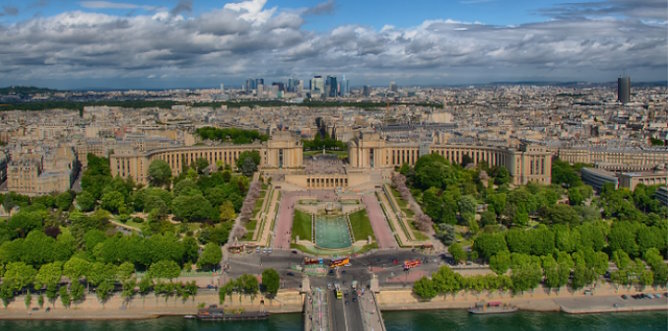
The Trocadéro Gardens, an Olympics site, are a must-see for anyone who wants to best admire the Eiffel Tower. They are the gardens of the Trocadéro Palace built for Paris 1878 world exhibition and demolished in 1937 to make room for the Palais de Chaillot. Paris Olympics map. Paris gardens. Paris monuments.
Trocadéro Gardens
In between the Palais de Chaillot and the Eiffel Tower, the Trocadéro Gardens are a must-see for anyone who wants to admire the Eiffel Tower. The Trocadéro Gardens are notable for the Warsaw Fountain (1937). A series of cascading basins dominates a large basin whose 20 water cannons discharge 8,240m3 of water per hour and form 56 sprays which end their course in eight staircases of water. The large waters of the central pool are highlighted by a play of lights which in the evening enlivens the statues with the heads of bulls and golden horses.
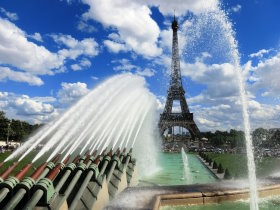
Trocadéro Fountains are facing Eiffel Tower
Trocadero Gardens map
The Trocadéro Gardens map shows Palais de Chaillot, the fountains, the Seine River with Pont d'Iena towards Eiffel Tower.
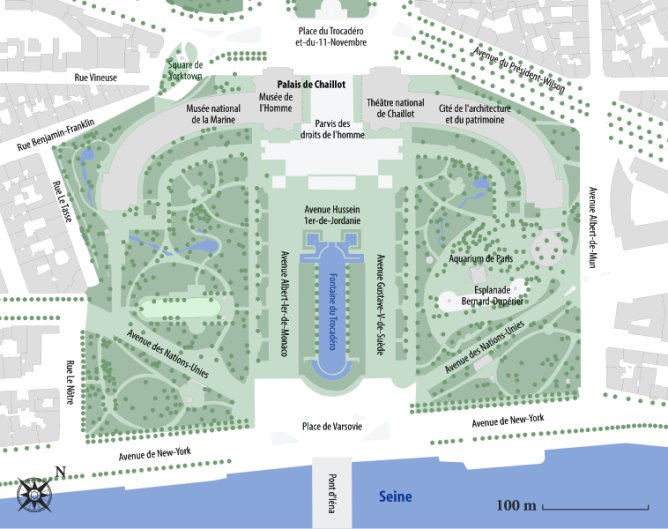
Trocadéro Palace facts
The 1878 Palais du Trocadéro - Trocadéro Palace - was designed by architects Gabriel Davioud and Jules Bourdais. Its mauresque architecture housed the largest concert hall ever built with 4,600 seats. Its decoration mobilized the best artists at the time. Large animal sculptures made for it have been transferred in front of Musée d'Orsay. Like the Eiffel Tower, the Trocadéro was controversial. Parisians called it the crab. It was ultimately demolished and replaced in 1937 by Palais de Chaillot.
The name Trocadéro was kept for Trocadéro Gardens, Place du Trocadéro, the address of Palais de Chaillot, the metro station on line 9 and 6. Parisians also regularly name Trocadéro the Palais de Chaillot.

The old Trocadéro was built in 1878
Palais de Chaillot
The Palais de Chaillot, which replaced the Trocadéro Palace in 1937, hosts the Paris Maritime Museum, the Cité de l'architecture, a museum devoted to France's monuments and the Musée de l'Homme.
Paris metro: Trocadéro station on lines 6 and 9
Locate Palais de Chaillot on Paris map.
Paris 75116 France

Fontains of Palais de Chaillot
Stay in top Paris hotel with indoor pool

Palace near Trocadéro Gardens
A former residence of Prince Roland Bonaparte, listed as a historical monument, Shangri-La Hotel is a hotel palace located 500m away from Trocadéro Gardens, facing the Eiffel Tower in the opposite river bank.
The hotel combines Asian hospitality and French art de vivre. It has 2 restaurants, one of them a Michelin star, an indoor pool and a spa. Many rooms have Eiffel Tower views.
Paris 75016 France
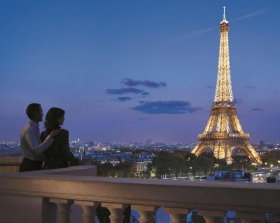
Hotel Shangri-La is a superb palace
Hotel near Trocadéro Gardens
Hotel Etoile Trocadéro is in the 16th arondissement, within walking distance of Trocadéro Gardens and Champs Elysées.
It offers air-conditioned rooms with satellite TV and private bathroom. Each room at Hotel Etoile Trocadero features a minibarand a hairdryer. A dry-cleaning service is available.
A continental breakfast is provided every morning and can be served in the guest rooms. Guests arriving late can benefit from 24-hour reception and they can also leave their bags during the day. Daily newspapers are provided, along with Wi-Fi access.
Paris 75016 France
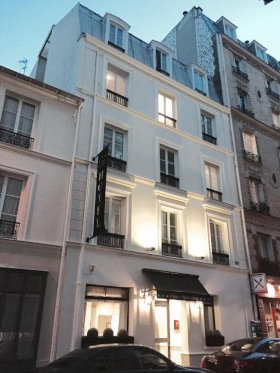
Hotel Etoile Trocadéro is near Place du Trocadéro
History of Palais du Trocadéro
The 60m high Chaillot Hill along the Seine river is facing the Eiffel Tower. Napoléon's project to build there a Palais du Roi de Rome for his son never materialized. The Palais du Trocadéro, built for Paris 1878 world exhibition, was named after the 1823 Trocadéro battle in Spain, when the fortified Isla del Trocadéro was captured by French forces led by the Duc d'Angoulême, son of the future King of France, Charles X. After the battle, the autocratic Spanish Bourbon Ferdinand VII was restored to the throne of Spain.

Palais de Chaillot is Place du Trocadéro
Trocadéro battle history
On August 31, 1823, a French expeditionary force captured Fort Trocadéro, which defended the port of Cadiz, Spain. This modest success is the first feat of glory for the French armies since the defeat at Waterloo.
At the fall of Napoleon I, the Bourbons had returned to the throne in France but also in Spain with the King Ferdinand VII. Unlike Louis XVIII in France, Ferdinand VII le Désiré did not resign himself to a constitutional monarchy. From May 4, 1814, he repealed the 1812 Constitution set up by the liberal junta of Seville and restored absolutism, even if it meant betraying those who liberated the country and raised it to power at the risk of their lives.
But in 1820, troops rose up when leaving for America with the mission of restoring Madrid's authority over the insurgent colonies. The uprising spread throughout the country and on March 10, 1820, the king resigned himself to restoring the Constitution of 1812.
For three years described as the “Liberal Triennium”, the kingdom returned to a form of freedom but Ferdinand VII did not disarm and waited for the opportune moment to restore absolutism. This is how, in secret, he appealed to the Holy Alliance of European monarchs to drive out the liberal deputies from the Assembly of Cortes and restore his power. Viscount François-René de Chateaubriand, who had given up writing to become Louis XVIII's Minister of Foreign Affairs, seized the opportunity to offer the French army easy success and the Bourbons revenge after the humiliations of the Empire. revolutionary era. He overcame the reluctance of King Louis XVIII and the President of the Council, Count Jean-Baptiste Villèle, who were reluctant to go to war, and finally got the representatives of the Holy Alliance meeting in Verona to entrust France with giving a lesson to Spanish liberals. This can be seen as a first application of the “right of interference”.
The expeditionary force of 80,000 men was placed under the command of the Duke of Angoulême, nephew of King Louis XVIII. The latter, who had no experience of war, was assisted by General Guilleminot, a former soldier of the Empire, as well as Marshals Oudinot and Moncey and Generals Molitor and Lauriston who will win their baton thanks to the campaign. As expected, the case was a "military walk". Nothing to do with the guerrilla warfare against Napoleon I, As the French approached Madrid, the Liberal-held Assembly of Cortes transfered the royal family to Cadiz, Andalusia. The French army crossed the peninsula in pursuit. It arrived in front of the city. The fort of Trocadéro, which defended the port of Cadiz, was taken with the bayonet, at low tide, by the soldiers who did not hesitate to throw themselves into the water. The affair ended with modest losses on the French side (35 killed).
After which, the victors bombarded the city to obtain its surrender. It was the only battle of the expedition, pompously qualified by the Spanish curators as the expedition of the Cien Mil Hijos de San Luis (“Hundred Thousand Sons of Saint Louis”). The Duke of Angoulême brought the lamentable Ferdinand VII back in his vans from Cadiz to Madrid. Back in Paris, to acclamations, he was pleased that the expedition had "provided the king with a good army and restored to France the consideration it should have had in Europe".